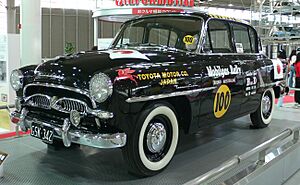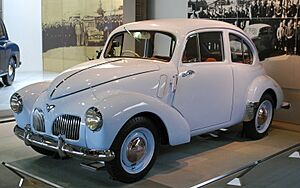History of Toyota facts for kids

The history of Toyota began in 1933. At first, it was a special part of a company called Toyoda Automatic Loom Works. This part was created to make cars. It was led by Kiichiro Toyoda, the son of the company's founder.
Kiichiro Toyoda had traveled to Europe and the United States in 1929. He wanted to learn how cars were made. By 1930, he started studying gasoline engines. The Japanese government wanted more cars made in Japan, especially because of a war with China. This encouraged Toyoda Automatic Loom Works to start making vehicles.
Kiichiro Toyoda saw this chance and started the Automotive Production Division on September 1, 1933. They began getting ready to build test cars. In 1934, this division made its first Type A Engine. This engine was used in the first A1 passenger car in May 1935. It was also used in the G1 truck in August 1935. Toyota started making the Model AA passenger car in 1936. Early Toyota cars looked a lot like Dodge and 1930s Chevrolet vehicles. Some parts could even be swapped between them.
Today, the Toyota Group is famous for its cars. But it still works in the textile business. It still makes automatic looms, which are now run by computers. It also makes electric sewing machines that are sold all over the world.
Contents
How Toyota Began
Toyota Motor Co. became its own separate company in 1937. The founding family's name was "Toyoda" (豊田 in Japanese writing). But the company name was changed to "Toyota" (トヨタ). This new name has 8 strokes when written in Japanese. Eight is considered a lucky number in East Asian culture. In countries where Chinese is spoken, the company is still called by its original Chinese characters (豐田).
In the 1930s, Japan's economy was growing fast. Both Ford and GM had built factories in Japan. They would bring car parts from America and put them together there. Ford's factory in Yokohama started in March 1925. GM built a factory in Osaka starting in April 1927. By 1929, Ford and GM made most of the cars sold in Japan. They produced 28,000 vehicles that year.
When Toyota was developing its first car, the Toyota AA, they bought cars made by GM and Ford in Japan. They took them apart to see how they worked. Toyota also hired engineers who had worked at the Japanese Ford and GM factories. This helped them develop their own Toyota products.
Toyota During World War II
During World War II, Toyota focused on making trucks for the Imperial Japanese Army. Because Japan had very few supplies, military trucks were made as simple as possible. For example, the trucks had only one headlight in the middle of the front. The war ended just before the Allied forces were going to bomb Toyota's factories. These factories were in the Aichi area.
Growing After the War
After World War II, Japan faced very tough economic times. Toyota started making passenger cars again in 1947 with the SA model. By the end of 1949, the company was almost bankrupt. But Toyota managed to get a loan from several banks. The banks said Toyota needed to have a separate sales team. They also said the company had to let go of some workers.

In June 1950, Toyota only made 300 trucks. It was very close to going out of business. The company announced that some workers would be laid off. They also said wages would be cut. In response, the workers' union went on strike for two months. The strike ended with an agreement. This agreement included layoffs and pay cuts. It also meant that the president at the time, Kiichiro Toyoda, had to resign.
Taizo Ishida took over as president. He was the head of the Toyoda Automatic Loom company. In the first few months of the Korean War, the US military ordered over 5,000 vehicles from Toyota. This helped the company recover. Ishida was praised for investing in new equipment. For example, the Motomachi Plant was built in 1959. This gave Toyota a big advantage over Nissan in the 1960s.
In 1950, a separate company, Toyota Motor Sales Co., was created. This company handled all sales until July 1982. In April 1956, the Toyopet dealer network was set up. In 1957, the Crown became the first Japanese car sent to the United States. Toyota also opened its American and Brazilian branches that year.
Toyota Around the World
Toyota began to grow a lot in the 1960s. They built a new research and development center. They also started working in Thailand. Toyota produced its 10 millionth car. They also won a Deming Prize for quality. Partnerships were made with Hino Motors and Daihatsu. The first Toyota car built outside Japan was on November 12, 1962. It was made in São Bernardo do Campo, Brazil. By the end of the 1960s, Toyota was known worldwide. The company had sent out its one-millionth car to other countries.
The first Japanese cars to arrive in the Americas were five Land Cruisers. They arrived in El Salvador in May 1953. The first Toyotas sent to Canada were 115 Crowns. They arrived in February 1965.
The first Toyotas sent to Europe were two Toyopet Tiaras. They went to Finland for testing in June 1962. No sales happened right away, but the importer showed the cars to the news in October that year. The first European company to import Toyotas was Erla Auto Import A/S in Denmark. They brought in 400 Crowns after an agreement in May 1963. They became the distributor for Denmark, Norway, and Sweden. The Netherlands followed in May 1964. After getting started in countries that made few or no cars, other markets followed in 1966. In 1968, Toyota set up its first European assembly plant in Portugal.
Recent Years (2008–2012)
In mid-2008, gas prices were high and the US economy was weak. Toyota reported a big drop in sales for June. This was similar to what other big car makers in Detroit reported. For Toyota, this was mainly because sales of its Tundra pickup trucks were slow. Also, there weren't enough fuel-efficient cars like the Prius, Corolla, and Yaris. Because of this, Toyota announced plans to stop making trucks at some plants. They shifted production at other factories to make cars that people wanted more.
In January 2010, Toyota stopped selling eight car models. This was to fix accelerator pedals that could get stuck. In December 2012, Toyota announced they had reached an agreement. This agreement was to resolve issues related to unintended acceleration in some of their vehicles. They made sure these problems were fixed.



